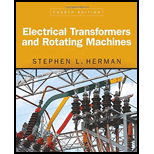Solutions for EBK ELECTRICAL TRANSFORMERS AND ROTATIN
Problem 3RQ:
Why should the secondary winding of a CT never be disconnected from its load when there is current...Problem 4RQ:
A current transformer has a ratio of 600:5. If three loops of wire are wound through the transformer...Problem 5RQ:
Assume that a primary current of 75 amperes flows through the windings of the transformer in...Problem 7RQ:
A current transformer has 4 turns of wire in its primary winding. How many turns of wire are needed...Problem 9RQ:
A CT has a current flow of 80 amperes in its primary winding and a current of 2 amperes in its...Problem 10RQ:
What is the most common use for a CT?
Browse All Chapters of This Textbook
Chapter 1 - MagnetismChapter 2 - Magnetic InductionChapter 3 - Inductance In Alternating-current CircuitsChapter 4 - Single-phase Isolation TransformersChapter 5 - AutotransformersChapter 6 - Current TransformersChapter 7 - Three-phase CircuitsChapter 8 - Three-phase TransformersChapter 9 - Single-phase Loads For Three-phase TransformersChapter 10 - Transformer Installation
Chapter 11 - Transformer CoolingChapter 12 - Transformer MaintenanceChapter 13 - HarmonicsChapter 14 - Direct Current GeneratorsChapter 15 - Direct Current MotorsChapter 16 - AlternatorsChapter 17 - Three-phase MotorsChapter 18 - Single-phase MotorsChapter 19 - Motor Maintenance And TroubleshootingChapter 20 - Motor Nameplate DataChapter 21 - Motor Installation
Sample Solutions for this Textbook
We offer sample solutions for EBK ELECTRICAL TRANSFORMERS AND ROTATIN homework problems. See examples below:
Chapter 1, Problem 1RQChapter 2, Problem 1RQChapter 3, Problem 1RQChapter 4, Problem 1RQThe given values are shown in below table: PrimarySecondary 1Secondary 2Secondary...The given values are shown in below table: PrimarySecondary 1Secondary 2Secondary...Chapter 5, Problem 1RQGiven: The number of turns between the windings A−B (NA−B) is 120. The number of turns between the...The differences in the connection between the primary winding of the voltage transformer and primary...
Given: The number of phases of the system (n) is 3. Calculation: The below figure represents the...The given values are shown in below table: Alternator (A)Load 1 (L1)Load 2 (L2)Load 2 (L2)EP(A)...Chapter 8, Problem 1RQThe given values are shown in below table: Primary (P)Secondary (S)Load (L)EP(P) EP(S) EP(L) IP(P)...Chapter 9, Problem 1RQGiven: The secondary voltage (V) is 240 V. The rating of the transformer (VA) is 15 kVA. The...Chapter 11, Problem 1RQChapter 12, Problem 1RQThe harmonics in an electrical system refers to the current and the voltage at a frequency is the...A device that converts the mechanical energy into electrical energy is called as generator. The...DC motor is a device that is used to convert direct current electrical energy into mechanical...Chapter 16, Problem 1RQThe three basic types of three-phase motors are as mentioned below. 1. Synchronous motors: The AC...A split phase motor is a type of induction motor which contains a single cage rotor. The two...Chapter 19, Problem 1RQThe National Electrical Manufacturers Association defines some basic parameters regarding the design...Given: The power of the motor (P) is 20 hp. The voltage applied to the motor (V) is 500 V....Given: Horsepower of the motor (P) is 75 hp. Line voltage (V) is 230 V. Power factor (F) is 80%....
More Editions of This Book
Corresponding editions of this textbook are also available below:
Related Mechanical Engineering Textbooks with Solutions
Still sussing out bartleby
Check out a sample textbook solution.
